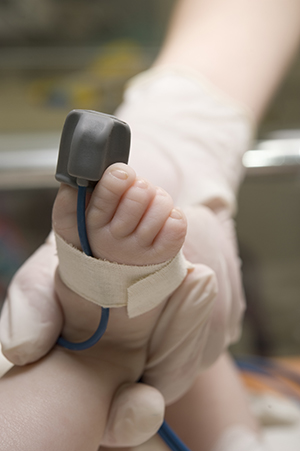Pulse Oximetry Screening for Congenital Heart Defects
Pulse Oximetry Screening for Congenital Heart Defects
Sometimes a baby is born with a heart problem. This is known as a congenital heart defect. The baby may seem healthy and fine. But the defect could cause a serious threat to his or her life. A test called pulse oximetry can help find if there is a problem before a baby goes home from the hospital. This can help a baby get early treatment if needed.
What is pulse oximetry?
Pulse oximetry is a simple, painless, and quick screening test. It checks to see if your baby has enough oxygen in his or her blood. This can help find out if your baby’s heart has a problem or is not working normally.
The test is done when your baby is 24 to 48 hours old, or right before going home from the hospital. During the test, a small sensor is put on the baby’s right hand and foot. The sensor is attached to a small device with a computer in it. The sensor tells the device how much oxygen is in the baby’s blood. The number shown on the device can tell your child’s healthcare provider if there is not enough oxygen in the blood. This can mean a congenital heart defect.
What pulse oximetry can find
Pulse oximetry can help find 7 critical congenital heart defects:
Hypoplastic left heart syndrome, when the left side of the heart doesn’t fully develop
Pulmonary atresia, when the pulmonary valve doesn’t form or work normally
Tetralogy of Fallot, when the heart has a combination of problems including a large hole in the heart and a blocked pulmonary valve.
Total anomalous pulmonary venous return, when veins from the lungs go to the wrong parts of the heart
Transposition of the great arteries, when the two large arteries that leave the heart are switched in position
Tricuspid atresia, when the tricuspid valve doesn’t form or work normally
Truncus arteriosus, when the two heart arteries arise from the heart as a single blood vessel.
Coarctation of aorta or interrupted aortic arch
Double outlet right ventricle
Ebstein's anomaly
Single ventricle
Risks of pulse oximetry
There are no risks associated with pulse oximetry. But the test does not find all heart defects. The test may even miss a defect it was meant to find. Your baby will also need to have a medical history and physical exam to help in the screening process. You should also make sure to stay on schedule with your baby’s medical checkups.
Updated:
February 14, 2018
Sources:
Newborn screening for critical congenital heart disease using pulse oximetry, Up To Date, Swenson, AK., PUlse oximetry for newborns: SHould it be routine? Journal of Family Practice (61)5; 283-286
Reviewed By:
Ayden, Scott, MD,Bass, Pat F. III, MD, MPH,Image reviewed by StayWell medical illustration team.
